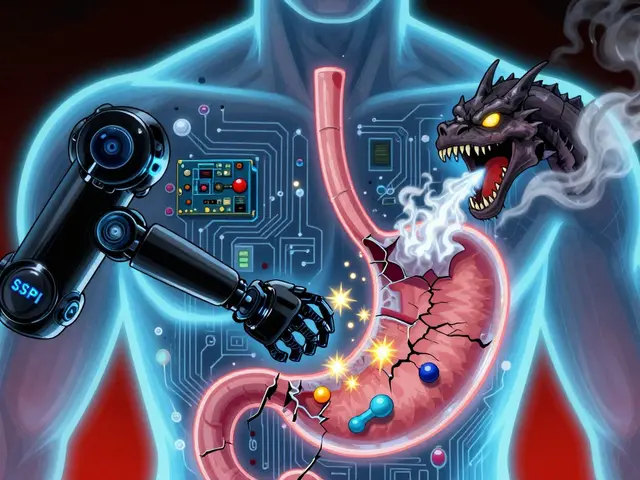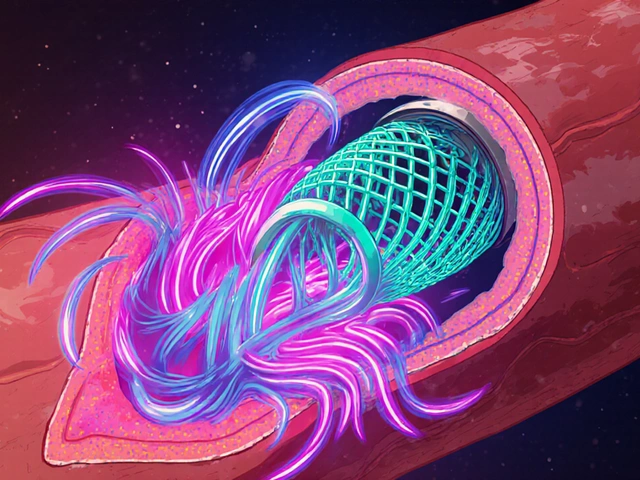Most people think color blindness means seeing the world in black and white. That’s not true. For the vast majority of people with color vision issues, it’s about red-green color blindness-a condition that doesn’t take away sight, but changes how colors are perceived. It’s not rare. About 8% of men and 0.5% of women worldwide live with it. And it’s not something you develop later in life. You’re born with it. The reason? Your genes.
How Red-Green Color Blindness Works
Your eyes have three types of cone cells that detect color: one for red, one for green, and one for blue. Red-green color blindness happens when the red or green cone cells don’t work right. This isn’t about damaged eyes or poor vision-it’s about faulty pigments inside those cells. These pigments are made by proteins called opsins, coded by two genes: OPN1LW for red and OPN1MW for green. Both sit on the X chromosome, right next to each other.
Here’s the catch: the red gene is usually alone, but there are often multiple green genes lined up after it. During sperm and egg formation, these genes can accidentally swap pieces. If a green gene gets mixed with part of a red gene, it becomes a hybrid that doesn’t respond properly to green light. That’s how most cases of deuteranomaly (the most common form) happen. In rarer cases, one of these genes is just missing entirely, leading to protanopia or deuteranopia-where one color is completely invisible.
People with protanopia can’t see red at all. Reds look dark, almost black. Greens and yellows blend together. Deuteranopes see green as muddy or brownish. Deuteranomaly, the mildest and most common form, means green looks a little off-like it’s washed out. Most people don’t even realize they have it until they’re tested.
Why Men Are Affected More Than Women
Men make up nearly all cases of red-green color blindness. Why? Because of how sex chromosomes work. Men have one X and one Y chromosome. Women have two X chromosomes. The genes for red and green vision are on the X chromosome. So if a man inherits one X with a faulty color gene, he has no backup. He’s affected.
Women need two faulty copies-one on each X chromosome-to have the condition. That’s rare. Even if a woman carries one bad copy, her other X chromosome often compensates. That’s why only about 0.5% of women are affected, compared to 8% of men. It’s not just a coincidence. It’s math: 8% of men being affected means roughly 8% of women carry the gene. But for a woman to be color blind, she needs to inherit the gene from both parents. That happens about once in every 200 women.
This is why you’ll often see color blindness passed from a grandfather to his grandson through his daughter. The daughter doesn’t see it, but she carries it. Her son has a 50% chance of getting the faulty X and being affected.
What Colors Are Hard to Tell Apart?
It’s not just red and green. The real issue is shades that rely on those two colors. Think:
- Red traffic lights vs. green traffic lights-especially in fog or glare
- Green grass vs. red berries
- Brown and orange
- Purple and gray
- Blue and purple
People with red-green color blindness often see these as similar tones. They don’t see them as “wrong”-they just don’t notice the difference. That’s why many go undiagnosed until school, when color-coded lessons trip them up. One study found 78% of adults with the condition struggled with color-coded charts and graphs in class.
Some people adapt brilliantly. A graphic designer in Wellington told me she uses brightness and pattern instead of color to differentiate elements in her designs. “I don’t need to see red and green differently,” she said. “I just need to make sure they’re not the only thing telling the story.”

How It’s Diagnosed
The most common test is the Ishihara test-those plates with colored dots forming numbers. If you can’t see the number, you might have a deficiency. But it’s not perfect. Some people guess correctly by spotting brightness differences. Others pass the test but still struggle in real life.
More accurate tests include the Farnsworth-Munsell 100 Hue Test, which asks you to arrange colored caps in order. Or the anomaloscope, where you mix red and green light to match a yellow. These are used in clinical settings, especially for jobs where color matters: pilots, electricians, train operators.
Many people don’t get tested until they’re applying for a job. One Reddit user, a commercial pilot applicant, wrote: “I had 20/20 vision. I passed every test. But when they showed me the Ishihara plates, I failed. I was disqualified. I didn’t even know I was color blind until then.”
Tools and Adaptations That Help
There’s no cure. But there are tools that make life easier.
EnChroma glasses are the most well-known. They cost between $330 and $500 and filter out overlapping wavelengths of light. For about 80% of people with deuteranomaly or protanomaly, they make colors pop-especially reds and greens. They don’t fix the gene. But they help you see the difference. One user said, “I saw my daughter’s red sweater for the first time and cried.”
Digital tools are just as important. Apple and Windows both have built-in color filters that shift hues to make reds and greens more distinct. The free app Color Oracle lets designers simulate how their work looks to someone with color blindness. The Colorblindifier plugin for Photoshop has been downloaded over 45,000 times.
There’s also ColorADD, a universal symbol system used in 17 countries. It adds simple shapes to colors: a triangle for red, a square for green, a circle for blue. It’s on public transport signs, school materials, and even in pharmacies.

What It Means in Daily Life
Most people with red-green color blindness don’t consider it a disability. In a survey of 850 people, 92% called it a “minor inconvenience.” But the small things add up.
- Choosing clothes that match (37% reported embarrassment over clashing colors)
- Reading color-coded maps or charts
- Identifying ripe fruit or spoiled meat
- Telling if a wire is live (red vs. green in electrical work)
Some careers are harder. Pilots, electricians, firefighters, and graphic designers often face barriers. But laws are changing. The UK’s Equality Act 2010 recognizes color blindness as a disability. Employers must make reasonable adjustments-like labeling wires, using patterns instead of colors, or allowing color filters on screens.
What’s Next? Science and Hope
Research is moving fast. In 2022, scientists at the University of Washington gave gene therapy to adult squirrel monkeys with red-green color blindness. Within weeks, they could see red and green like normal monkeys. The effect lasted over two years.
The National Eye Institute is now funding work to see if the same could work in humans. It’s not about curing it overnight. It’s about giving people back the ability to see the world as most others do.
For now, the best tools are awareness and adaptation. Schools are starting to use patterns in graphs. Websites follow WCAG 2.1 guidelines to ensure color isn’t the only way to convey information. Even Apple and Microsoft now offer color filters built into their operating systems.
Red-green color blindness isn’t a flaw. It’s a variation. And like any variation, it’s best met with understanding-not pity, not correction, but accommodation.
Can color blindness get worse over time?
No. Red-green color blindness is congenital and doesn’t change with age. It’s not degenerative. If you were born with it, you’ll have the same level of color vision your whole life. However, other eye conditions like cataracts or macular degeneration can affect color perception later on-but those are separate issues.
Are there different types of red-green color blindness?
Yes. There are four main types: protanopia (no red cones), deuteranopia (no green cones), protanomaly (red cones don’t work right), and deuteranomaly (green cones don’t work right). Deuteranomaly is the most common, affecting about 5% of men. Protanopia and deuteranopia are less common but more severe. Protanomaly and deuteranomaly are milder and often go unnoticed.
Can women be color blind?
Yes, but it’s rare. A woman needs to inherit the faulty gene from both her mother and father. Since only about 8% of men are affected, and only half of those pass the gene to daughters, the chance of a woman having two faulty copies is very low-about 0.5%. Most women who carry the gene don’t show symptoms, but they can pass it to their children.
Do color-correcting glasses work for everyone?
No. They work best for people with deuteranomaly or protanomaly-those with abnormal but present cone cells. They don’t help people with complete loss of red or green cones (protanopia or deuteranopia). Also, they don’t restore normal color vision. They just make some colors more distinct. Many users report improved contrast, not full-color restoration.
Is color blindness considered a disability?
In many places, yes. Under the UK’s Equality Act 2010 and similar laws in the EU and Canada, color blindness is recognized as a disability when it limits daily activities. Employers must make reasonable adjustments-like using labels instead of color codes or offering digital filters. It’s not about pity. It’s about access.






Kevin Wagner
November 13, 2025 AT 22:12Bro, I didn't even know I was color blind until I tried to pick out matching socks in college. Thought I was just bad at fashion. Turns out my green shirt looked like a muddy brown to me. EnChroma glasses? I'm saving up. If I can see my daughter's red hair like everyone else, it's worth every penny.
gent wood
November 15, 2025 AT 06:11I've worked in electrical engineering for 22 years, and I still use tape labels on every wire. No one ever asked why. I didn't want to explain it. But now, with the new UK regulations, I feel seen. It's not a flaw-it's just how my brain processes light. I'm glad more workplaces are adapting.
Dilip Patel
November 15, 2025 AT 09:43USA and UK people always make it sound like color blindness is some big deal. In India, we have 1.4 billion people and no one cares. You learn to read the position of traffic lights, not the color. Why do you need glasses for this? Just use your brain. Also, why are you all so obsessed with Apple filters? We have smartphones too, you know.
Jane Johnson
November 15, 2025 AT 13:19It's interesting how the article frames this as a 'minor inconvenience.' That language minimizes the systemic barriers faced by individuals in professional environments. The normalization of color-dependent interfaces in education and employment constitutes a form of ableism that remains largely unaddressed.
Peter Aultman
November 16, 2025 AT 06:50I'm deuteranomalous and I've never had a problem. I just know that if something looks green and red to everyone else but the same to me, I go by brightness or context. I once told my boss my chart looked weird and he changed it to patterns. No big deal. People overcomplicate this.
Sean Hwang
November 16, 2025 AT 20:54My cousin is color blind and he's a chef. He uses texture and smell more than color. He says he can tell if meat's done by how it feels, not by the redness. He even taught me how to tell ripe avocados by touch. People don't realize how much we adapt without even thinking about it.
Barry Sanders
November 17, 2025 AT 15:27Wow. Another feel-good article about color blindness. Let me guess-next you'll be telling me that people who can't hear high frequencies are 'special' and need 'accommodations.' Get real. This isn't a disability. It's a genetic quirk. Stop treating people like they need pity.
Chris Ashley
November 18, 2025 AT 07:26Wait so if my dad's color blind and my mom's a carrier, does that mean I'm doomed? I'm 23 and I still mix up red and green. I just thought I was dumb. I'm gonna get tested tomorrow. Thanks for the info, I guess.
kshitij pandey
November 19, 2025 AT 10:33As someone from India, I want to say: we've been using ColorADD on metro signs since 2018. It's simple, it's effective, and it doesn't cost a fortune. Why do Western countries need expensive glasses when a few symbols can do the job? We don't need tech to solve human differences-we need inclusion.
Brittany C
November 19, 2025 AT 22:27The neurobiological underpinnings of opsin gene recombination on the X chromosome are particularly fascinating. The homologous recombination events between OPN1LW and OPN1MW loci result in chimeric photopigments with altered spectral sensitivities, which is why deuteranomaly is so prevalent. This is not merely a 'color perception issue'-it's a molecular genetics phenomenon.
Sean Evans
November 20, 2025 AT 11:17Ugh. Another 'color blind person is just special' story. You know what’s really sad? People who buy $500 glasses to feel better about themselves. Meanwhile, real people are struggling with rent and food. This is performative empathy. 🤡
Anjan Patel
November 21, 2025 AT 18:55My cousin got kicked out of the Indian Air Force because of this. They didn't even give her a chance to use filters. They just said 'no.' I cried for a week. This isn't about vision. It's about bureaucracy. They need to change the rules. Why punish someone for biology?
Scarlett Walker
November 22, 2025 AT 11:02I'm a graphic designer and I use Color Oracle every day. It changed my life. I used to get so frustrated when clients said 'make it pop' and I had no idea what they meant. Now I design with contrast and shape first. Turns out, better design helps everyone-not just color blind people.
Kevin Wagner
November 24, 2025 AT 01:03^This. I used to design logos in CMYK and thought I was being creative. Turns out I was making them unreadable. Now I check everything in grayscale first. Best habit I ever picked up.